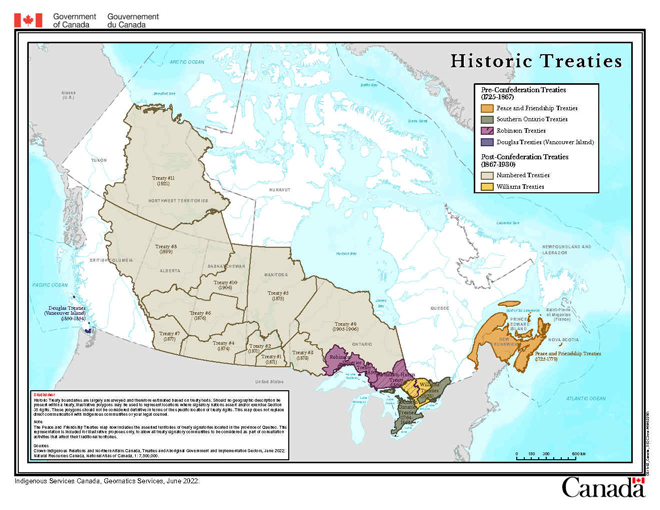Summaries of Pre-1975 Treaties

Credit: AANDC
Since the first meetings between First Nation peoples, European explorers and colonisers in North America, a relationship was created between these two groups based on diplomatic traditions and protocols. This relationship is demonstrated by the various treaties made between Europeans and First Nation peoples.
These treaties, negotiated and concluded between the Crown and many of Canada's First Nations, are foundational documents in the history of Canada. They established peaceful relations during times of colonial war, helped stimulate prosperous economic and commercial trade relations, and allowed for the organised expansion of Canada. Without these treaties, Canada would likely not be as we know it today.
Archived - Read the History of Treaty-Making in Canada.
Treaties of Peace and Neutrality (1701-1760)
As the British and the French struggled for control of North America, they transformed their respective commercial partnerships with First Nations into vital military alliances that brought much needed support to both camps and in some cases concluded the earliest treaties such as the 1701 Albany Deed. At the end of the Seven Years’ War, the British military commanders concluded two treaties in 1760: the Treaty of Swegatchy, with the main group of Aboriginal French allies, and the Huron-British Treaty, with the Huron-Wendat of Lorette. These two treaties marked a period of neutrality for France's former Aboriginal allies in exchange for continued access to traditional territories for the Algonquins, the protection of First Nation village sites, the right to trade with the British and the protection of traditional practices for the Huron.
Read more about Treaties of Peace and Neutrality (1760).
Peace and Friendship Treaties (1725-1779)
Between 1725 and 1779, the British authorities in Nova Scotia undertook the signing of a series of treaties with the Mi'kmaq, Maliseet and Passamaquoddy of the Maritimes. Allies of France in Acadia for over a century, the Mi'kmaq, Maliseet and Passamaquoddy were often called to arms and defended themselves against British military and colonists during the numerous conflicts between France and Great Britain.
Read more about Peace and Friendship Treaties (1725-1779).
Upper Canada Land Surrenders and the Williams Treaties (1764-1862/1923)
In the Great Lakes region, more than 30 land cessions were negotiated by agents of the Indian Department and Aboriginal peoples between 1764 and 1862. These land surrenders, mostly one time cash payments with no or few ongoing obligations, permitted the development of southern and eastern Ontario.
In 1916, a Commission of inquiry jointly created by Ontario and Canada proposed that a new treaty be negotiated in the region between Georgian Bay, the Ottawa River, Lake Simcoe and the lands west of the Bay of Quinte. The 1923 Williams Treaties, taking its name for the head of the Royal Commission, ceded all lands in the region to the Crown for a fixed one time cash payment.
Read more on the Upper Canada Land Surrenders and the Williams Treaties.
Robinson Treaties and Douglas Treaties (1850-1854)
In 1850, William Robinson negotiated two treaties with the Aboriginal inhabitants, mainly Ojibwa, of the northern Great Lakes region. One treaty covered the area of the north shore of Lake Superior (Robinson-Superior Treaty), while the other covered the Lake Huron and Georgian Bay areas (Robinson-Huron Treaty). These two treaties are quite different from those negotiated in the southern part of the province as the Robinson treaties promised the creation of reserves, annuities and the continued right to hunt and fish on unoccupied lands.
In the same year, James Douglas, Chief Factor and later governor of the Hudson Bay Company colony on Vancouver Island, undertook the negotiation of the first of fourteen treaties with certain Island First Nations. These treaties, negotiated between 1850 and 1854, surrendered lands near Hudson Bay Company posts and in Victoria in exchange for the continued right to hunt and fish, reserve lands and a one-time payment.
Read more on the Robinson Treaties and Douglas Treaties.
The Numbered Treaties (1871-1921)
With the purchase of the Rupert's Land charter from the Hudson's Bay Company in 1869 and the creation of the Province of Manitoba in 1870, the Dominion of Canada undertook the conclusion of a series of treaties between 1871 and 1921 so as to secure Aboriginal title in the Northwest. Modelled on the 1850 Robinson Treaties, eleven treaties were negotiated to encompass all of the Prairies, northern Ontario and the Peace River and Mackenzie River valleys.
The Numbered Treaties are largely responsible for the agricultural and settlement expansion across the Canadian Prairies, the construction of the transcontinental railway and the affirmation of Canadian sovereignty throughout the Northwest Territories.
Read more about The Numbered Treaties.